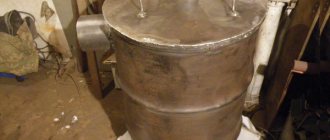What is biogas and how is it formed?
As a result of biomass processing, biogas is obtained
Biogas is classified as an environmentally friendly fuel. According to its characteristics, biogas is in many respects similar to natural gas produced on an industrial scale. The technology for producing biogas can be presented as follows:
- in a special container called a bioreactor, the process of processing biomass takes place with the participation of anaerobic bacteria under airless fermentation conditions for a certain period, the duration of which depends on the volume of loaded raw materials;
- as a result, a mixture of gases is released, consisting of 60% methane, 35% carbon dioxide, 5% other gaseous substances, among which there is a small amount of hydrogen sulfide;
- the resulting gas is constantly removed from the bioreactor and, after purification, is sent for its intended use;
- processed waste, which has become high-quality fertilizers, is periodically removed from the bioreactor and transported to the fields.
Visual diagram of the biofuel production process
In order to establish continuous production of biogas at home, you must own or have access to agricultural and livestock enterprises. It is economically profitable to produce biogas only if there is a source of free supply of manure and other organic waste from animal husbandry.
Gas heating remains the most reliable heating method. You can learn more about autonomous gasification in the following material:
Use Cases
Processing manure into biogas makes it possible to obtain electrical, thermal and mechanical energy. This fuel is used on an industrial scale or in private homes. It is used for:
- heating;
- lighting;
- heating water;
- operation of internal combustion engines.
Using a bioreactor, you can create your own energy base to power your private home or agricultural production.
Thermal power plants using biogas are an alternative way to heat a private farm or small village. Organic waste can be converted into electricity, which is much cheaper than running it to the site and paying utility bills. Biogas can be used for cooking on gas stoves. The great advantage of biofuel is that it is an inexhaustible, renewable source of energy.
Types of bioreactors
Installations for the production of biogas differ in the type of loading of raw materials, collection of the resulting gas, placement of the reactor relative to the surface of the earth, and material of manufacture. Concrete, brick and steel are the most suitable materials for constructing bioreactors.
Based on the type of loading, a distinction is made between bio-installations, into which a given portion of raw materials is loaded and goes through a processing cycle, and then completely unloaded. Gas production in these installations is unstable, but any type of raw material can be loaded into them. As a rule, they are vertical and take up little space.
A portion of organic waste is loaded into the system of the second type daily and an equal portion of ready-made fermented fertilizers is unloaded. The working mixture always remains in the reactor. The so-called continuous feeding plant consistently produces more biogas and is very popular among farmers. Basically, these reactors are located horizontally and are convenient if there is free space on the site.
The selected type of biogas collection determines the design features of the reactor.
- balloon systems consist of a rubber or plastic heat-resistant cylinder in which a reactor and a gas holder are combined. The advantages of this type of reactor are simplicity of design, loading and unloading of raw materials, ease of cleaning and transportation, and low cost. The disadvantages include a short service life, 2-5 years, and the possibility of damage as a result of external influences. Balloon reactors also include channel-type units, which are widely used in Europe for processing liquid waste and wastewater. This rubber top is effective at high ambient temperatures and there is no risk of damage to the cylinder. The fixed dome design has a completely enclosed reactor and a compensating tank for slurry discharge. Gas accumulates in the dome; when loading the next portion of raw materials, the processed mass is pushed into the compensation tank.
- Biosystems with a floating dome consist of a monolithic bioreactor located underground and a movable gas holder, which floats in a special water pocket or directly in the raw material and rises under the influence of gas pressure. The advantage of a floating dome is ease of operation and the ability to determine gas pressure by the height of the dome. This is an excellent solution for a large farm.
- When choosing an underground or above-surface installation location, you need to take into account the slope of the terrain, which makes it easier to load and unload raw materials, enhanced thermal insulation of underground structures, which protects the biomass from daily temperature fluctuations and makes the fermentation process more stable.
The design can be equipped with additional devices for heating and mixing raw materials.
We install the installation
Scheme of a biogas plant with manual loading
At the first stage, you need to decide on the amount of possible raw materials, how much animal waste accumulates every day, how much grass or cake you can afford to spend on heating needs. Determine the volume of the reaction box in which you plan to produce gas, and select a location for installation. This is the most crucial moment. The equipment should be installed in a separate room to avoid emergency situations (after all, we are dealing with dangerous methane gas) and taking into account the unpleasant odor emitted during operation. The final stage: we install pipes for loading and unloading material. We prepare a hole of the required size for the equipment.
So, the reactor tank is placed in a prepared pit or against the wall of a separate room, the pipes are connected, we proceed to the installation of the loading compartment and the gas exhaust system.
We install a cover on the inlet, which will serve as a door for loading raw materials into the firebox. We check the tightness. Remember that oxygen should not enter the system. We produce thermal insulation. The biogas plant is made with your own hands and is ready for use. Congratulations!
With manual loading without heating or with natural/pneumatic heating - this is the most functionally simple power plant. To manufacture it, you will need a reactor, a tank for loading raw materials, a device for selecting and using the resulting gas, and a device for unloading the fermented material. According to the specified scheme, any owner can make the installation.
You can watch the biogas production installation process in more detail in the video:
Is it profitable to make a reactor and use biogas?
The construction of a biogas plant has the following goals:
- production of cheap energy;
- production of easily digestible fertilizers;
- savings on connecting to expensive sewerage;
- recycling of farm waste;
- possible profit from gas sales;
- reducing the intensity of unpleasant odors and improving the environmental situation in the area.
Profitability chart for biogas production and use
To assess the benefits of building a bioreactor, a prudent owner should consider the following aspects:
- the cost of a bio-plant is a long-term investment;
- homemade biogas equipment and installation of a reactor without the involvement of third-party specialists will cost much less, but its efficiency is also lower than that of an expensive factory one;
- To maintain stable gas pressure, the farmer must have access to livestock waste in sufficient quantity and for a long period of time. In the case of high prices for electricity and natural gas or the lack of possibility of gasification, the use of the installation becomes not only profitable, but also necessary;
- for large farms with their own raw material base, a profitable solution would be to include a bioreactor in the system of greenhouses and cattle farms;
- For small farms, efficiency can be increased by installing several small reactors and loading raw materials at different time intervals. This will avoid interruptions in gas supply due to a lack of feedstock.
You can find out how to install heating in a private house without gas here:
Underground biofuel production plant
To save space, it is best to build underground installations. This is the easiest way to get biogas at home. To set up an underground bioreactor, you need to dig a hole and fill its walls and bottom with reinforced concrete.
Holes are made on both sides of the container for the inlet and outlet pipes. Moreover, the outlet pipe should be located at the base of the container for pumping out the waste mass. Its diameter is 7-10 cm. The entrance hole with a diameter of 25-30 cm is best located in the upper part.
Biofuel underground installation
The installation is covered with brickwork on top and a gas tank is installed to receive biogas. At the outlet of the container you need to make a valve to regulate the pressure.
A biogas plant can be buried in the yard of a private house and sewage and livestock waste can be connected to it. Recycling reactors can completely cover a family's electricity and heating needs. An additional benefit is getting fertilizer for your garden.
A DIY bioreactor is a way to get energy from pasture and make money from manure. It reduces farm energy costs and increases profitability. You can do it yourself or order installation. The price depends on the volume, starting from 7,000 rubles.
How to build a bioreactor on your own
The decision to build has been made, now you need to design the installation and calculate the necessary materials, tools and equipment.
Important! Resistance to aggressive acidic and alkaline environments is the main requirement for bioreactor material.
If a metal tank is available, it can be used provided it has a protective coating against corrosion. When choosing a metal container, pay attention to the presence of welds and their strength.
A durable and convenient option is a polymer container. This material does not rot or rust. A barrel with thick hard walls or reinforced will withstand the load perfectly.
The cheapest way is to lay out a container made of brick or stone or concrete blocks. To increase strength, the walls are reinforced and covered inside and outside with a multi-layer waterproofing and gas-tight coating. The plaster must contain additives that provide the specified properties. The best shape to withstand all pressure loads is oval or cylindrical.
At the base of this container there is a hole through which waste raw materials will be removed. This hole must be tightly closed, because the system only works effectively in sealed conditions.
Calculation of necessary tools and materials
To lay out a brick container and install the entire system, you will need the following tools and materials:
- container for mixing cement mortar or concrete mixer;
- drill with mixer attachment;
- crushed stone and sand for constructing a drainage cushion;
- shovel, tape measure, trowel, spatula;
- brick, cement, water, fine sand, reinforcement, plasticizer and other necessary additives;
- welding machine and fasteners for installation of metal pipes and components;
- a water filter and a container with metal shavings for gas purification;
- tire cylinders or standard propane cylinders for gas storage.
The size of the concrete tank is determined from the amount of organic waste that appears daily in a private farmstead or farm. Full operation of the bioreactor is possible if it is filled to two-thirds of the available volume.
Let us determine the volume of the reactor for a small private farm: if there are 5 cows, 10 pigs and 40 chickens, then per day of their life activity a litter of 5 x 55 kg + 10 x 4.5 kg + 40 x 0.17 kg = 275 kg + is formed 45 kg + 6.8 kg = 326.8 kg. To bring chicken manure to the required humidity of 85%, you need to add 5 liters of water. Total weight = 331.8 kg. For processing in 20 days you need: 331.8 kg x 20 = 6636 kg - about 7 cubic meters only for the substrate. This is two thirds of the required volume. To get the result, you need 7x1.5 = 10.5 cubic meters. The resulting value is the required volume of the bioreactor.
Remember that it will not be possible to produce large amounts of biogas in small containers. The yield directly depends on the mass of organic waste processed in the reactor. So, to get 100 cubic meters of biogas, you need to process a ton of organic waste.
Preparing a site for a bioreactor
To obtain free biofuel on the site, you must select a place to build a reinforced concrete tank that will serve as a bioreactor.
The optimal location is chosen away from residential premises and places where animals are placed. A raw material storage warehouse may be nearby. The groundwater level and the convenience of loading and unloading biomass should be taken into account. A place for the supply of raw materials is desirable.
An economical placement of the reactor tank is to build it below ground level. The slope of the terrain is also very convenient. This will reduce the cost of thermal insulation and make it easier to load the organic substrate.
The reliability of the design and durability of the reactor directly depends on the preparation of the bottom and walls of the pit for the container. Walls are strengthened and sealed using plastic, concrete, and polymer rings. Careful insulation is also important. Straw, clay, dry manure and slag, and improvised materials are used as cheap insulation.
Assembly and installation of the unit
To save budget, it is optimal to install a simple and reliable design without bells and whistles, and then, during operation and when financial opportunities arise, add additional elements for heating, automation, and control.
Visual diagram of the bioreactor device
Step-by-step instructions for assembling and installing the bioreactor will help you install the installation yourself.
- Dig a pit, pour a leveling layer of sand onto the bottom, cover the entire pit with PVC film, then pour a thermal insulating layer of expanded clay, straw, and level it to the horizon. Install pipes for loading and unloading the substrate. The raw material pipes must have a diameter of at least 300 mm, otherwise they will clog.
- Lay out a brick container or install a ready-made one. Insulate the side walls of the reactor by covering them with clay and straw in several layers or using modern insulation materials, for example, polystyrene foam, polyurethane foam.
- Make a gas drainage system consisting of vertical pipes with numerous holes throughout the body. This system will replace agitators.
- Cover the outer layer of the loaded bio-raw material with a special film to create a slight excess pressure and accumulate biogas under the dome. Install a dome, which must be sealed, a gas exhaust pipe at the top, filters for cleaning, a sealed hatch, and a water seal. Gas is accumulated and stored in special gas holder bags.
Starting up the bioreactor
- For the bioreactor to operate efficiently, it must be loaded with raw materials to 2/3 of its volume and the temperature required for bacteria to work, so the hopper for supplying biomass should be placed on the sunny side so that it warms up.
- Loading new and removing spent organic substrate is cheaper and easier to do using the overflow principle, i.e. a rise in the level of organic matter inside the reactor when a new portion is introduced will remove the substrate through the unloading pipe in a volume equal to the volume of the introduced material.
- Load a batch of bacteria. Reheat if necessary.
Correct gas removal from the bioreactor
The gas produced during the fermentation of organic matter is removed through a special hole provided in the design of the upper part of the lid, which tightly closes the tank. To eliminate the possibility of biogas mixing with air, it is necessary to ensure its removal through a water seal (hydraulic seal).
You can control the pressure of the gas mixture inside the bioreactor using the lid, which should rise when there is excess gas, that is, play the role of a release valve. You can use a regular weight as a counterweight. If the pressure is normal, then the exhaust gas will flow through the outlet pipe into the gas tank, being cleaned in water along the way.
The resulting gas is discharged through a special hole located in the lid structure
Operating and safety rules
Constant loading of the next batches and unloading of ready-made fertilizers, control of fermentation conditions will ensure the correct operation of the biogas plant.
Specialized companies sell batches of bacteria fermenting organic matter to produce biogas.
There are mesophilic, thermophilic and psychrophilic bacteria. Complete fermentation of organic matter with the participation of thermophilic bacteria will occur in 12 days. Mesophilic bacteria work slower; they process raw materials in 20 days.
The biomass in the reactor must be stirred at least twice a day, otherwise a crust will form on the surface, preventing the free release of biogas. During the cold season, the reactor should be heated, maintaining the optimal temperature for maximum product production.
Making a fireplace for an apartment using environmentally friendly fuel is not difficult if you have the proper desire and appropriate instructions. Details:
The organic mixture loaded into the reactor should not contain antiseptics, detergents, chemicals that are harmful to the life of bacteria and slow down the production of biogas.
Important! Biogas is flammable and explosive.
For proper operation of the bioreactor, the same rules must be followed as for any gas installations. If the equipment is sealed and biogas is discharged into the gas tank in a timely manner, then there will be no problems.
If the gas pressure exceeds the norm or poisons if the seal is broken, there is a risk of explosion, so it is recommended to install temperature and pressure sensors in the reactor. Inhaling biogas is also dangerous to human health.
What is this?
Biogas, which is an environmentally friendly fuel, is produced in biogas plants, units that are a complex of technical structures and devices combined into a single technological cycle.
The configuration of a biogas plant can be different, depending on its power, the type of raw materials and the resulting final product in the form of thermal or electrical energy, both types of energy, or only biogas used in household gas stoves and as fuel for cars.
Standard installation consists of the following components and assemblies:
- A storage tank in which raw materials used to produce biogas are accumulated;
- Mixers and mills of various designs, dividing large fractions of raw materials into smaller ones;
- Gas holder, a hermetically sealed container that serves as a storage tank for the resulting gas;
- A reactor, container or reservoir in which the process of biofuel formation occurs;
- Systems for feeding raw materials into the reactor of the installation;
- A system for transferring the resulting fuel from the reactor and gas tank, further to the stages of processing and conversion into other types of energy;
- Automation systems, protection and control over the production processes of gas and its processed products.
The above diagram roughly shows the technological cycle of biogas production using liquid and solid raw materials, with its further processing and production of thermal and electrical energy.
How to ensure biomass activity
You can speed up the fermentation process of biomass by heating it. As a rule, this problem does not arise in the southern regions. The ambient temperature is sufficient for the natural activation of fermentation processes. In regions with harsh climatic conditions in winter, it is generally impossible to operate a biogas production plant without heating. After all, the fermentation process starts at a temperature exceeding 38 degrees Celsius.
There are several ways to organize heating of a biomass tank:
- connect the coil located under the reactor to the heating system;
- install electric heating elements at the base of the container;
- provide direct heating of the tank through the use of electric heating devices.
Bacteria that influence methane production are dormant in the raw materials themselves. Their activity increases at a certain temperature level. The installation of an automated heating system will ensure the normal course of the process. The automation will turn on the heating equipment when the next cold batch enters the bioreactor, and then turn it off when the biomass warms up to the specified temperature level.
Similar temperature control systems are installed in hot water boilers, so they can be purchased in stores specializing in the sale of gas equipment.
The diagram shows the entire cycle, starting from the loading of solid and liquid raw materials, and ending with the removal of biogas to consumers
It is important to note that you can activate biogas production at home by mixing biomass in a reactor. For this purpose, a device is made that is structurally similar to a household mixer. The device can be set in motion by a shaft that is output through a hole located in the lid or walls of the tank.
Raw materials for production
When rotting and heating, organic substances produce heat, and the gas output is uneven. We provide a list of raw materials (in ascending order) that are most often used in biogas production, in m3/t:
- whey from milk, fruit and vegetable cake (up to 70);
- animal excrement and bird droppings (from 60 to 130);
- corn and fish waste (up to 300);
- remains of killed animals, waste from slaughterhouses (up to 320);
- freshly cut grass (up to 350);
- glycerin for technical needs (up to 500);
- grain crops (up to 600);
- fat (up to 1300).
On farms, such an installation is indispensable:
- firstly, there is no need to remove and dispose of waste;
- secondly, a high percentage of biogas output will allow significant savings on space heating;
- thirdly, biomass rotted in the plant is an excellent fertilizer.
A biogas plant requires effort, materials and time, but it pays for itself in literally 1 year.











